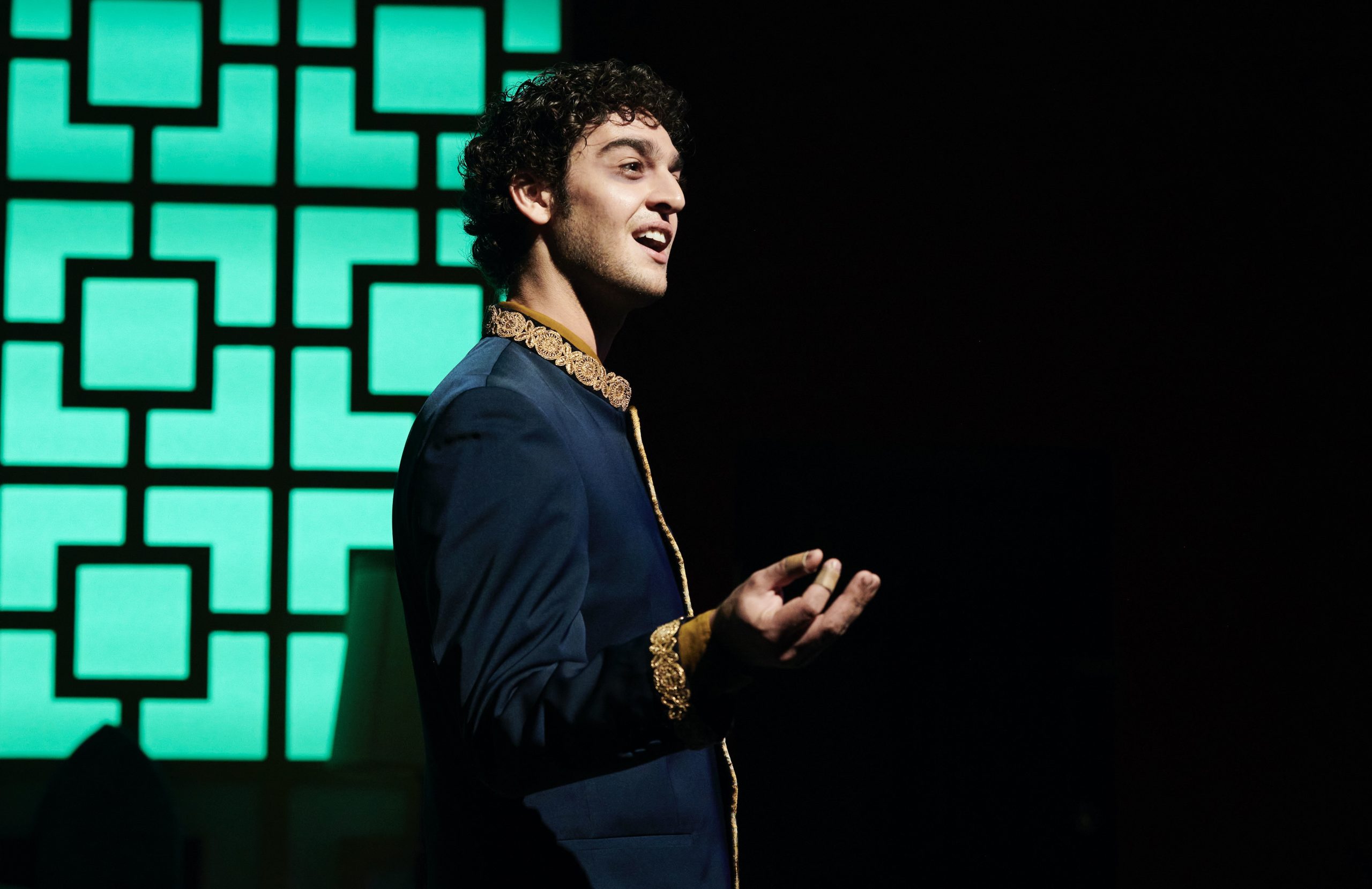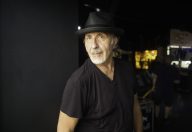A State-of-the-Art Two-Hander: City’s ‘Andy Warhol in Iran’
- Like
- Digg
- Del
- Tumblr
- VKontakte
- Buffer
- Love This
- Odnoklassniki
- Meneame
- Blogger
- Amazon
- Yahoo Mail
- Gmail
- AOL
- Newsvine
- HackerNews
- Evernote
- MySpace
- Mail.ru
- Viadeo
- Line
- Comments
- Yummly
- SMS
- Viber
- Telegram
- Subscribe
- Skype
- Facebook Messenger
- Kakao
- LiveJournal
- Yammer
- Edgar
- Fintel
- Mix
- Instapaper
- Copy Link

Andy Warhol (Jeffrey Emerson) nearly flips his fright wig when confronted by an ominous stranger.
Too bad Shakespeare didn’t write two-handers. The term is theater jargon for plays with only two characters, and given the possibilities of the form, it’s fascinating to imagine what the Bard might have done with it.
But actual fascination is available close at hand. Some contemporary playwrights are turning out sharp two-person plays. Try Brent Askari’s Andy Warhol in Iran, at City Theatre in Pittsburgh through May 12. This is the kind of play that gets you laughing while it slips a knife in the gut. It taps the format’s intimate potential, homing in on a one-to-one encounter that’s weird as heck but also brimming with passion. Real life includes many such encounters. The play captures their essence. The interaction it depicts is like a cross between a blind date and a presidential debate, except more fun than either, and arguably more meaningful.
What the Waiter Brought In
Andy Warhol in Iran is a fictional takeoff on true events. The true backstory in a nutshell: During the mid-1970s, Andy Warhol was in his late 40s and known worldwide, while Iran was an increasingly secular and Westernized nation—albeit one ruled by an autocratic, U.S.-backed monarchy that used secret police and terror tactics to squash political dissent. The Shah of Iran commissioned Warhol to paint portraits of his wife, Empress Farah Diba Pahlavi. In 1976, Warhol visited Tehran to take Polaroid photos as a basis for the finished work. He eventually produced portraits of both the Empress and the Shah himself, although they barely had time to enjoy the pictures. Anti-Shah agitation was brewing hot. The Iranian Revolution of 1978-79 drove the royal couple into exile and created the Iran we know today.
The play invites you to skip back to an evening in July of ‘76. The scene is a guest room at the Tehran Hilton. Warhol—played with a sort of swishy, gossipy gusto by Jeffrey Emerson—enters and addresses the audience directly. He says he’s going to show us an incident that happened the night before his photo session, or at least he thinks it did. Memory is slippery, you know.
Warhol orders from room service. The waiter—a young Iranian played with utter conviction by Arian Rad—solemnly rolls in a fancy table set with silver dining implements. But the waiter has another implement tucked in his jacket. It’s a handgun. The waiter, a revolutionary in disguise, informs Warhol that a kidnapping has commenced. He and his mates intend to hold the artist hostage to draw attention to their grievances against the cruel regime. Warhol, who’s been shot before, is terrified by the gun-waving. The waiter tells him he won’t be hurt if he follows orders. Grinning, the young man says the revolutionaries just want their 15 minutes of fame.

Going head to head with Warhol is a big ask. Arian Rad answers the call as Andy’s servant-turned-manhandler.
Shotgun Wedding
A bizarre bout of dickering and bickering ensues. The rebels want publicity? Warhol knows all about that! He used to be in advertising; he’ll make them an ad! Uh-uh, nothing doing. The game is hostage or bust.
The interplay between a dead-earnest rebel and a flaky, politically naive artist generates tension spiced with laugh lines galore. When Farhad (the young Iranian’s name) describes the Shah and his gang as “extremely decadent,” Warhol—a chronicler of the demimonde—asks “You mean, in a bad way?”
There’s plenty more where that came from. So many clever lines and revealing little exchanges that I don’t think I, as a reviewer, have ever scribbled so furiously in my notebook whilst watching a play. Sorry they can’t all be shared here. The important points are as follows.
Gradually—you might say predictably—the kidnapper and kidnappee grow closer. Warhol wonders aloud if he’s got Stockholm Syndrome. Farhad fumes “I have treated you like a human being and that’s a mistake.” Nonetheless, here’s an odd couple discovering grounds for commonality. Warhol is stunned to learn what the secret police have done to Farhad and his kin. Conversely, when Farhad chides Warhol for being a rich American painting trivial stuff like soup cans, Warhol says that after you’ve grown up in a working-class home, as he did, where his mother made soup for dinner out of ketchup and water, a can of Campbell’s tomato soup isn’t trivial: “It’s a miracle.”
And the miracle of Andy Warhol in Iran is that it overcomes so many seeming obstacles. Predictability does not interfere with the play’s punch. Tons of exposition have to be crammed in, and they are, pretty darn seamlessly. Passages that could have drowned in didactic social commentary rise up and sing. Actor Emerson does not look much like Andy Warhol, but after a while, who cares? The audience on opening night cared only for the result. Their applause was vigorous and well earned.
The play is reality fired at you through the double-barreled shotgun of fiction. A two-hander about two hands who should have met, even if they didn’t. Come and see.
Closing Credits and Ticket Info
Brent Askari’s Andy Warhol in Iran is directed for City Theatre by Marc Masterson. Masterson was the company’s longtime artistic director and has been co-artistic director since 2018; the play is the last he will direct in that role. Through May 12 in the mainstage theater at 1300 Bingham St., South Side. Visit City on the web for ticket reservations and details.
Scenic design is by Michael Raiford, with lighting by Paul Whitaker, sound by Zachary Beattie-Brown, projections by Mike Tutaj, and costumes by Susan Tsu. Mehrnaz Tiv served as dramaturg and cultural consultant for the play. Samuel GC Muñoz is the fight choreographer, Sade Namei the dialect coach, and Patti Kelly the production stage manager.
Photos: Kristi Jan Hoover.
Mike Vargo, a Pittsburgh-based freelancer, writes about theater and the visual arts for Entertainment Central.
Share on Social Media
- Like
- Digg
- Del
- Tumblr
- VKontakte
- Buffer
- Love This
- Odnoklassniki
- Meneame
- Blogger
- Amazon
- Yahoo Mail
- Gmail
- AOL
- Newsvine
- HackerNews
- Evernote
- MySpace
- Mail.ru
- Viadeo
- Line
- Comments
- Yummly
- SMS
- Viber
- Telegram
- Subscribe
- Skype
- Facebook Messenger
- Kakao
- LiveJournal
- Yammer
- Edgar
- Fintel
- Mix
- Instapaper
- Copy Link
Follow Entertainment Central
Sign up for the EC Newsletter
Latest Stories







